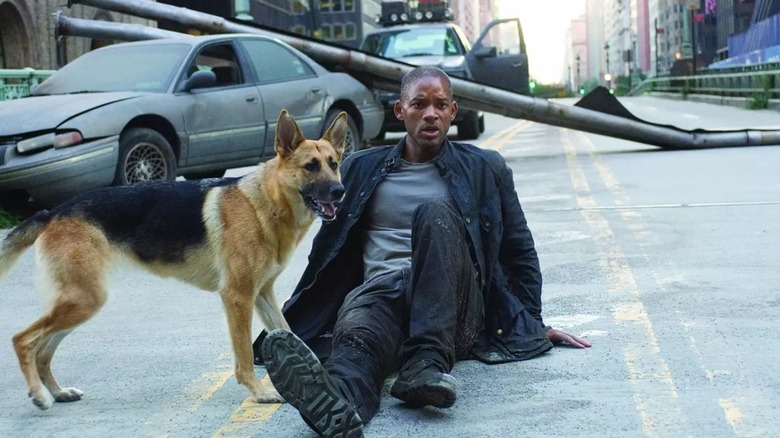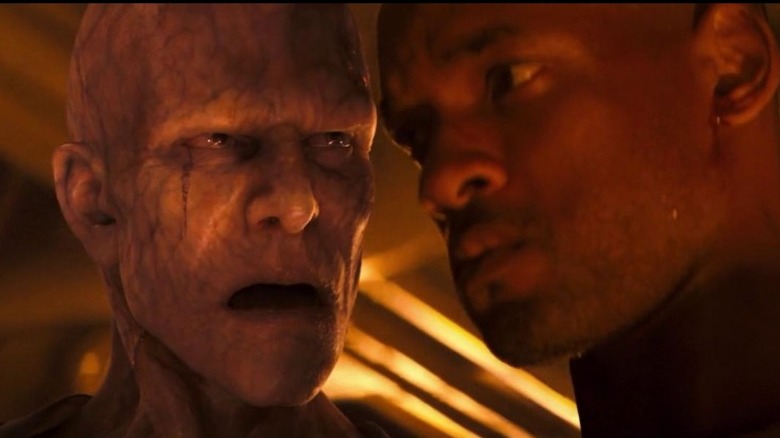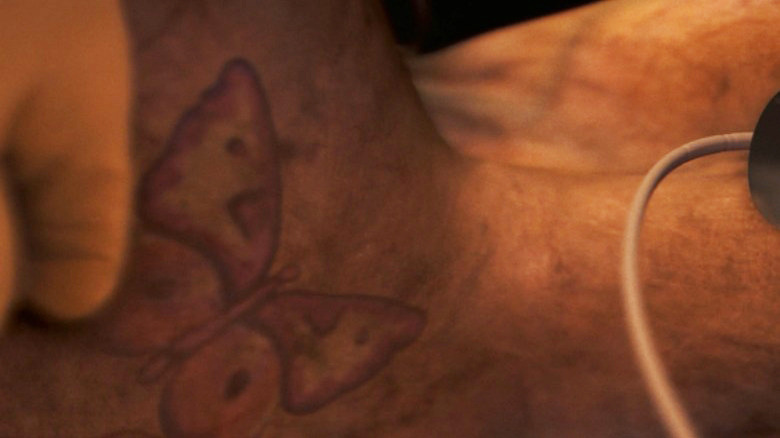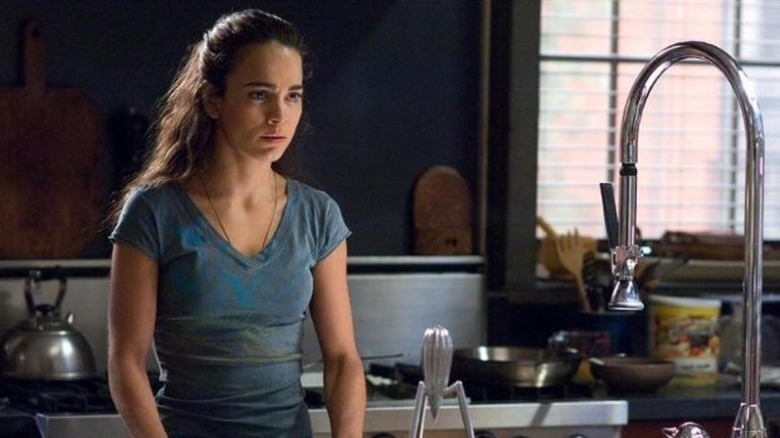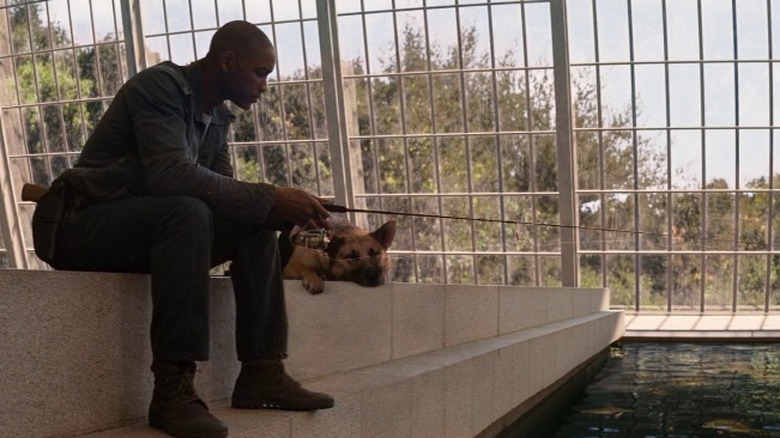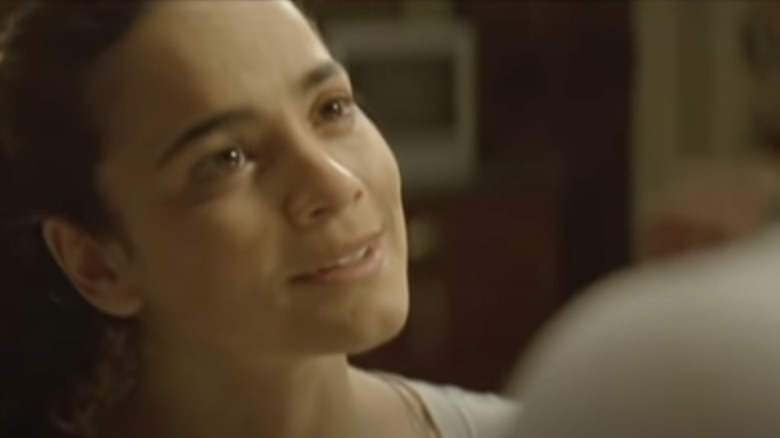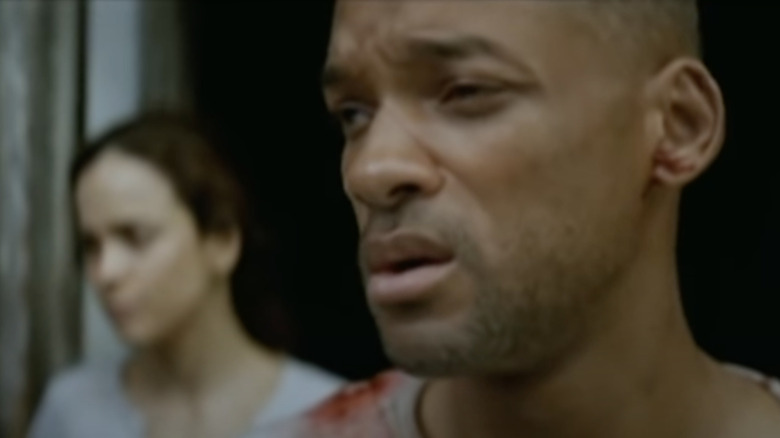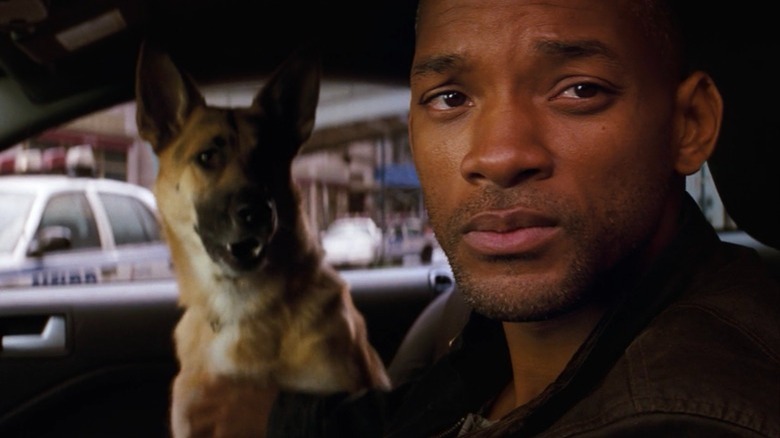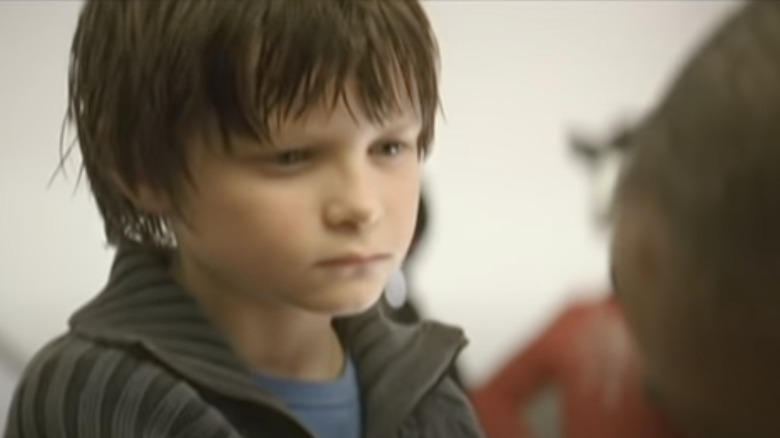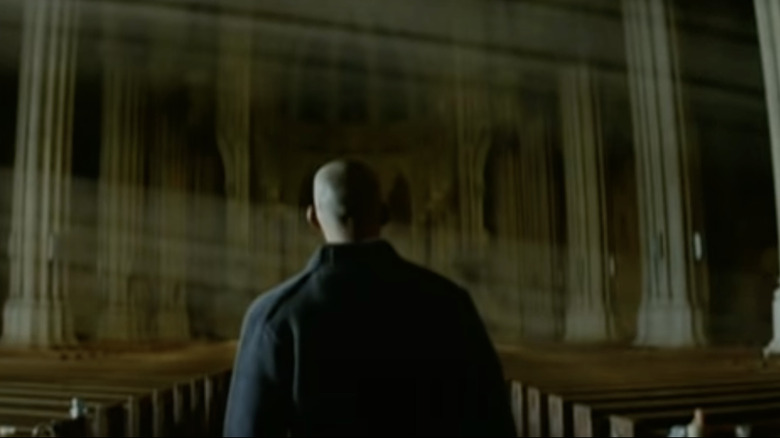I Am Legend Deleted Scenes That Change Everything
Francis Lawrence's feature adaptation of Richard Matheson's 1954 novel of the same name was a remarkable success, grossing over $585 million total worldwide (not adjusted for inflation). Will Smith was at the apex of his action star career, coasting on the well-earned coattails he cemented in the 1990s with the likes of "Men in Black" and "Independence Day." All things considered, it was a serendipitous merging of creative forces. Matheson's novel is well-regarded as one of the century's greatest science fiction achievements (having been adapted several times, including in Boris Sagal's "The Omega Man"), and Smith is tailor-made for this kind of weighty, grim science fiction.
Unfortunately for some, "I Am Legend" only occasionally flirted with the greatness it was so close to achieving. Adapting any novel is a difficult prospect; the act of cutting and preserving, the hard choices made to tailor the written word to a visual medium. "I Am Legend," for its part, struggled considerably, sacrificing the heady themes of the source material for a more conventional, blockbuster ethos, including an ending widely regarded as outrageously bad and unearned.
Had these nine deleted scenes been included, there's a solid chance "I Am Legend" might be better viewed today. Ranging from alternate endings to crestfallen character beats, these scenes texturize Lawrence's adaptation, bringing it closer than ever to the heart of the original novel.
Alternate ending
The alternate ending of "I Am Legend" remarkably changes the movie's thematic resonance. In fact, additional deleted scenes seem, in large part, to have been cut principally on account of the movie's revamped ending. In the superior, cut ending, Will Smith's Robert Neville survives. As the Darkseekers swarm the basement, Neville recognizes their innate humanity. He returns a kidnapped Darkseeker from earlier in the film, shifting his perspective. Neville had long believed himself to be the lone survivor of a deadly pandemic. The zombie-like Darkseekers, in his mind, were obstacles, monstrous beings he simply needed to slaughter and kill.
The theatrical ending grounds Neville's perspective. In conventional Hollywood fashion, Neville successfully develops a cure and sacrifices himself in a literal blaze, allowing Alice Braga's Anna to escape with the cure. Neville learns nothing. The Darkseekers are rendered monsters in need of a cure. Roll credits. The alternate ending has Neville surviving, grappling with the sheer weight of the choices he's made throughout. It's a tougher, more complicated ending, one that better adheres to the rich moral complexity of Richard Matheson's original novel. Had it been included, "I Am Legend" would have been better for it.
The captured Darkseeker
In "I Am Legend's" alternate ending, Neville is prompted to return the captured female Darkseeker to the horde when the male leader outside attempts to draw a butterfly on the glass in Neville's basement. Recognizing the prompt, Neville recalls a butterfly tattoo he clocks in this deleted scene. At that moment, Neville recognizes he isn't a target. Instead, the horde is simply there to free a captured comrade.
The theatrical cut rightfully excised Neville's earlier recognition of the butterfly tattoo given how little impact it has on the theatrical ending. While the theatrical cut does see a butterfly appear in the cracked glass, it still ends with Neville throwing himself, armed with a grenade, toward the horde. Within the context of the alternate ending, though, this early scene highlights Neville's burgeoning doubt that the Darkseekers are simply monsters. The butterfly tattoo on the female Darkseeker especially augments Richard Matheson's core themes. A relic of the Darkseeker's innate humanity, it triggers Neville's shift from annihilator to empathizer.
Darkseekers setting traps
Will Smith and Alice Braga have remarkable chemistry. Audiences might not realize it from the movie's theatrical cut where Braga's Anna is introduced far too late into "I Am Legend," but as evidenced by the cut scenes, the two consistently elevate the material, striking at the core of what's made Richard Matheson's source material endure decades after it first released.
In one cut scene shortly after Anna's first meeting with Neville, the two have a prolonged conversation in the kitchen as Anna's young companion Ethan (Charlie Tahan) rests. They discuss the nature of the pandemic, the Darkseekers, and soon arrive at Neville's injury. Neville remarks about being injured in a trap, with Anna positing the Darkseekers themselves might have set it on purpose.
The revelation augments the Darkseekers' intelligence. To this point, Neville had considered them monstrous nothings, shells of violence with no genuine cognitive reasoning. By asserting they might be capable of setting traps, Anna accelerates Neville's shift in consciousness. The Darkseekers, in other words, aren't terribly unlike the humans they're hunting.
The Metropolitan Museum of Art
In one cut scene later in the movie, Anna, Neville, and Ethan visit The Metropolitan Museum of Art, specifically the Temple of Dendur exhibit. The theatrical version deleted several such scenes, almost all of which highlighted the growing characterizations of Anna and Neville specifically. At times, these cut scenes have the rhythm of a lighthearted, apocalyptic road movie, and it is as precisely as delightful as it sounds.
While at the exhibit, Neville and Anna talk as Ethan swims with the fishes. They question (building on the cut kitchen conversation of earlier) whether the Darkseekers have gotten smarter. Whether, in their own way, they have evolved, becoming more advanced and capable of surviving independently in the process.
As the conversation capstones, Neville tosses some food in for the fish in the pond. They flounder and Ethan remarks he's cold. This prompts Neville to recall the captured Darkseeker. Intuiting the virus might be cold sensitive, Neville is led to believe he needs to lower the temperate for the cure to prove effective. With profound implications for both the theatrical and alternate ending, it better fills in the gaps for how, exactly, Neville has managed to develop an ostensible cure.
Anna and Neville debate God
There are several cut scenes, as noted, that expanded on Anna and Neville's relationship in "I Am Legend," including a scene of the two driving together that contributed to the sheer chaos the shoot writ large caused in New York City. Late in the film, before the climactic attack, Anna and Neville have a heated discussion on the nature and very existence of God. The conversation ebbs and flows through several heady, existential topics, exploring how Anna and Neville have diametrically different approaches to their shared apocalypse.
Additionally expanded on with profound thematic resonance in several other cut scenes, their contentious debate is further proof that the alternate ending wasn't just the right call, but the scene the movie seemed to be building toward. With all the texture and probing character work cut, "I Am Legend" had little else to do but dazzle audiences with its effects and high-octane action sequences. While there is certainly an audience for it, Anna and Neville's conversation, had it stayed intact, might have shifted "I Am Legend" more toward the likes of the latest "Planet of the Apes" trilogy rather than something like "John Carter."
Neville opens the door
Film is a visual medium. The simplest shot can often accomplish what thousands of words couldn't. Following on the alternate ending (and similarly cut from the theatrical version), "I Am Legend" makes a pitstop at existential grief and regret before its optimistic destination. Neville, having been spared by the Darkseekers in his basement, emerges from the house as dawn breaks. As the sun crests overhead and the full New York skyline comes into view, Neville breaks down. In the fresh light of day, he can finally see what he's done, and the man he's become.
With the recognition of the Darkseekers' innate humanity, Neville grapples with what amounted to years of killing someone's mother, father, children, or lover. Driven only by an impulse to survive, Neville never before stopped to consider the full weight of his actions. While Neville's recognition here is only a preview for his full transformation to come, it better coalesces with the weighty, complicated ethos of Richard Matheson's novel. In other words, with deleted scenes like this, "I Am Legend," well, feels like "I Am Legend" rather than an "insert-here" seasonal blockbuster.
Time with Sam in Central Park
Fans of "I Am Legend" and movie audiences in general likely know it features one of the most tragic dog deaths in cinema history. For all that "I Am Legend" did wrong, they did absolutely knock it out of the park with Sam, Neville's German Shepherd companion and the goodest girl the apocalypse has ever known. After Sam is injured and contracts the virus, Neville is forced to put her down. It's a heartbreaking scene, with Francis Lawrence showing just enough for the full impact to be felt. Will Smith, for his part, is doing some career-best work contemporaneously, snuffing out the one friend he has left. With a cut scene returned, that death could have been even worse.
Early in the film, Sam and Neville are playing in Central Park. Sam is especially fond of a butterfly, chasing it around the field as she skips and hollers, with Neville laughing off in the distance. Beyond more insertions of the long-running butterfly motif, it's a necessary moment for Sam's burial later. In the theatrical cut, Neville simply buries Sam and moves on. Within the context of the deleted scene, audiences can spot Neville burying Sam in the spot they played earlier, rendering a tragic death even more heartbreaking.
Hugo Boss
As noted, several cut scenes see Neville, Anna, and Ethan out and about in New York City. While the movie's New York setting is certainly immersive, it is constrained by some conventional, post-apocalyptic notes, namely the fact that everything looks, well, post-apocalyptic. While city denizens especially might have an easier time clocking recognizable locales, general audiences might soon find it difficult to distinguish between one deserted street and another. With forays to the likes of The Metropolitan Museum of Art and others, the deleted scenes certainly do a better job representing New York City than the theatrical cut does on its own.
One such stop is at an abandoned Hugo Boss store. While there, the trio engages in a little lighthearted shopping, though as Anna steps away, Neville consults with Ethan as to whether he's capable of firing a gun. For as much as the movie posits the Darkseekers are the real monsters, moments like these help solidify man as the chief antagonist. Neville has no qualms about helping to guide Ethan toward being more like he is, despite Anna's righteous objections. Thematically, it's powerful, and once more, it highlights a growing theological schism between the three survivors, something the theatrical cut barely manages to acknowledge at all.
Neville goes to church
As a capstone to Neville's full shift in character following the alternate ending, Neville visits a church. A callback to an earlier scene where he, Ethan, and Anna stopped in, Neville fully reckons with the existence of a God. He recounts the world he knew and the world he, Anna, and Ethan are about to step into, fully accounting for his role in it, and the way he met violence with violence. With a forthcoming sequel where Will Smith is expected to return, it's a scene that profoundly changes where Neville's character might end up.
Richard Matheson never wrote a sequel to the original book, so where the film sequel is poised to go remains somewhat unclear. If it follows the alternate ending, though, Neville's reclamation of faith in the church, the possibility of God, and how to best cultivate a bright future has profound implications. It will be curious to see how the filmmakers endeavor to make a sequel work, though there's no doubt that Neville's arc in the church yields some of the most fruitful material.
